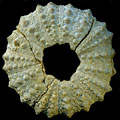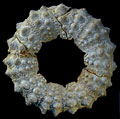| Type |
Cidarites mamillanus Roemer, 1836, by subsequent designation of Savin, 1903, p. 136,
Lambert & Thiery (1911, p. 189) also took the type species as P. mammillanum Roemer (Cidaris), refering specifically to the illustration in Desor & de Loriol [1868-72. Echinologie Helvetique. Terrain jurassique, p. 154, pl. 25, figs 2-3]. However, they (Lambert & Thiery 1925, p. 565) subsequently claimed that the specimen illustrated and described by Desor & de Loriol was different from Roemer\'s Cidaris mammillanum. They recognized that the specimen of Desor & de Loriol that they referred to in setting up this genus was synonymous with Wright\'s Diadema davidsonii and later corrected the type species designation for Polydiadema. It seems highly likely, nevertheless, that Wright\'s species is synonymous with Romer's, as Wright (1856, p. 132) originally believed.
|
| Species Included |
-
P. mammillanum (Roemer, 1836); Oxfordian, Europe.
-
P. priscum (Agassiz, 1840); Oxfordian, Europe.
-
P. bourgueti (Agassiz, in Agassiz & Desor, 1846); Valanginian-Berriasian, ?Aptian, Europe, North Africa and the Middle East.
-
P. bigranulatum (Gregory); Cenomanian-Turonian, Egypt [includes T. humei Fourtau and T. balli Fourtau].
-
P. depressa (Agassiz, in Agassiz & Desor, 1846); Aalenian-Bathonian, western Europe [?=T. homostigma (Agassiz, in Agassiz & Desor, 1846); Bajocian, France; =T. subcomplanata (d'Orbigny, 1850); Bathonian, France].
-
P. delgadoi (de Loriol); Hauterivian, Portugal.
-
P. deslongchampsi (Cotteau, 1869); Upper Toarcian, France.
-
P. fittoni (Wright, 1868); Aptian, England.
-
?P. gauthieri (Cotteau, 1885); Upper Pliensbachian, France [no phyllodes adorally, pore-pairs uniserial and tubercles very small!]
-
P. guerangeri (Cotteau, 1859); Cenomanian, France, Portugal.
-
P. inaequale (Agassiz, in Agassiz & Desor, 1846); Callovian, France.
-
P. neglecta (Thurmann, in Desor, 1856); Upper Oxfordian, Kimmeridgian, France
-
P. langi (Desor, 1856); Oxfordian, France.
-
P. princeps (Thurmann, in Desor, 1856); Oxfordian, France
-
P. randenensis (de Loriol, 1871); Oxfordian, Switzerland
-
P. rotularis (Agassiz, 1836); Neocomian- Barremian, France
-
P. superba (Agassiz, in Agassiz & Desor, 1846); Oxfordian, Europe
-
P. travisensis Smith & Rader, 2009; Albian, Texas, USA
-
Trochotiara priscum (Agassiz, 1840); Oxfordian, western Europe
-
T. inaequale Agassiz, in Agassiz & Desor, 1846); Bathonian-Callovian, France
-
T. prisciniacense (Cotteau, 1856); Lower Jurassic, France.
Lambert & Thiery (1910) included a number of other species in this genus, all with true polygeminate plating. These differ from Polydiadema in having 5 elements to each compound plate, and represent an unnamed taxon within the Emiratiidae. They include:
|




